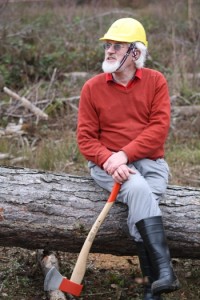
When Karen, Nick and I first began Save Our Woods way back in Jan 2011 I’m not sure we knew who Oliver Rackham was. We soon learned and it was an honour to receive a message from him offering his support for and wisdom to our campaign.
In amongst the scrum and racket of the tree world, Oliver Rackham was the most powerful voice of science and reason. His passing is an incredible loss but the gifts he has given us are immeasurable.
Rod Leslie, SoW contributor and inspiration, wrote a beautiful blog about the day that Oliver Rackham felled the last conifer at Chalkney Wood. I offer it again below as a small token of remembrance of this great man.
Chalkney Restored- a milestone for England’s Ancient Woodlands
Yesterday, 8th December 2011, marks a milestone for England’s Ancient Woodlands…
At 11am Professor Oliver Rackham personally felled the last conifer in Chalkney Wood!
Chalkney Wood near Earls Colne in north Essex is one of the ‘Lavenham Woods’ managed by the Forestry Commission that played a central role in the research that led to the concept of ‘Ancient Woodland’. Like so many other ancient woods, the Chalkney that Oliver wrote about in his seminal 1980 book ‘Ancient Woodland’ had been heavily planted with conifers by the Forestry Commission. Despite that he said that ‘Chalkney still gives one of the best impressions of medieval wood’.
I first visited Chalkney, with Oliver, in 1988. 3 years earlier thanks very largely to the work of Oliver Rackham and George Peterken forestry policy had changed dramatically to recognise the unique value of ancient woodland. However, the idea of actually removing conifers was quite revolutionary to the Forestry Commission and in what must be some of the earliest restoration in England local forester Simon Leatherdale had started some tentative felling along streams and ride sides.

Simon Leatherdale of the Forestry Commission who has spent over 20 years restoring the famous ‘Lavenham’ Ancient Woods
Today is the culmination of that early, cautious work. Simon has been working away ever since, gradually removing conifers. All the work has been done at a profit and by local ‘Higglers’, small scale forestry contractors. Support within the Forestry Commission has come and gone over that time: there were still people who saw felling immature trees as sacrilege.
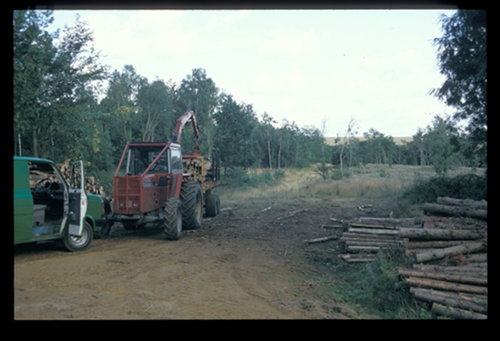
A ‘Higgler’ – a small scale forestry contractor – at work removing conifers in the Lavenham Woods. Here few broadleaves survived but coppice regrowth quickly re-establishes native species.
His work has been even more significant than simply restoring these very special woods: in 1985 both Oliver and George talked about woods ‘destroyed’ by conifer shading. Of Chalkney Oliver said in 1980 ‘ the native vegetation partly destroyed’.
Most of us would have agreed at the time: how could ground flora recover when the forest floor was quite bare apart from a carpet of conifer needles ? However, as Simon let the light back in, sometime by thinning, sometimes by felling, it became clear to Oliver that the woodland’s regenerative capacity was far greater than anyone had guessed. In fact today it would take a real expert to identify that many of the earliest restorations had ever had a conifer on them. The discovery gave new impetus to the restoration programme as it became clear that it really was possible to return to something close to the original ancient woodland.
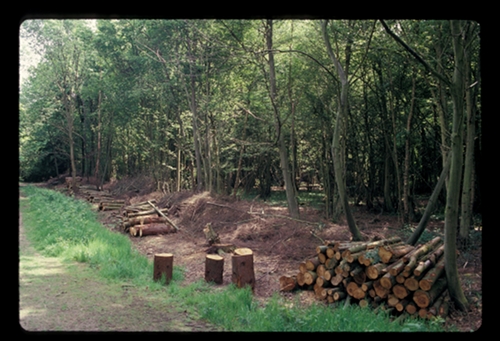
Early restoration: Conifers thinned out from amongst surviving broadleaves along a rideside. As of today not one conifer is left in Chalkney.
200 acre Chalkney is the quintessential Rackham wood: it is a ‘Pry Wood’ – Pry an ancient name for small-leaved lime. Largely ignored because of it’s absence from the pollen record, in recent times lime has been recognised as a key ancient woodland species. Chalkney is complex: as well as lime there is hornbeam, ash/maple/hazel, oak standards and even two wild service stools. The soils are acid sands and loess but calcareous springs feed the valleys.
Chalkney’s cultural history matches its ecological complexity. A Roman-British road dissects the wood which is still surrounded by intact medieval woodbanks. Once used for keeping ‘wild swyne’, probably after the extinction of true wild boar, there are early 17th century records of wood sales showing that lime bast, the bark used for making rope, was as valuable as the timber itself.
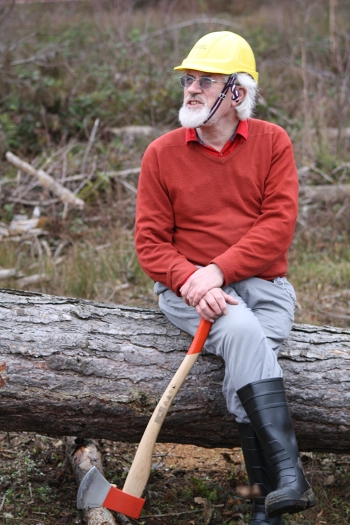
Professor Oliver Rackham, having a rest on the last conifer to be felled at Chalkney Wood, 8/12/2011




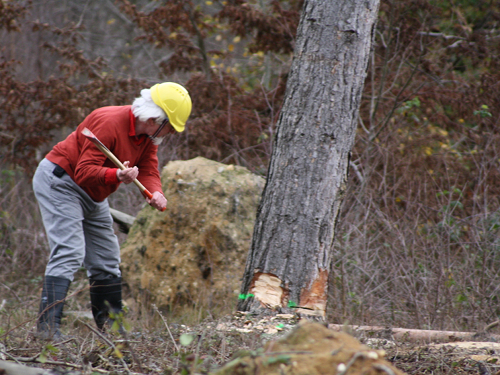
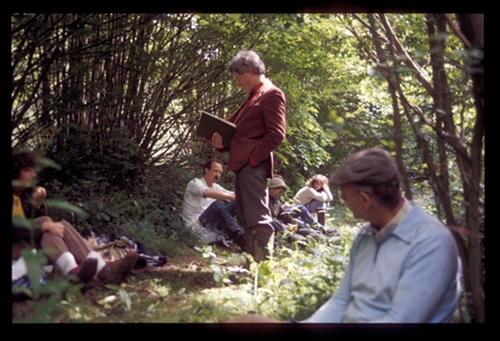

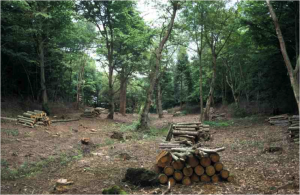























Hen – thanks for re-posting my blog ! It is hard to believe that Oliver is no longer with us. My friend and colleague Jonathan Spencer who worked on the original ancient woodland survey with gorge Peterken and Keith Kirby said he feels ‘hollowed out’. I feel the same. I was one of the many people whose eyes were opened by Oliver, on one of his amazing courses at Flatford Mill in the heart of ‘Rackham country’. It was his story telling: how he related the trees we visited in the woods to the buildings, and to the way people lived and their values. Thinking of the panel report, he really was the king of ‘woodland culture’. What gave me as much pleasure as anything in my career was when both Oliver and George agreed they had been wrong in their earlier view that ancient woodlands lost under conifers were gone forever – most of us shared that view – just look at the ground flora (or lack of it) under the Corsican Pine in my 1988 photos. It has been a thrill to all of us how these wonderful woods have sprung back to vigorous life. All of us in FC were, I think, thrilled that Oliver was able to see the last conifer gone from the Lavenham woods he made his own within his lifetime.